Tropisms in Plants

Pepper plants on the ISS (NASA/Megan McArthur)

Pepper plants on the ISS (NASA/Megan McArthur)
How does this align with my curriculum?
| Grade | Course | Topic |
|---|
Learn about the different ways that plants move in response to their environments.
Animals can move around to get what they need to survive. But did you know plants can also move? They can’t get up and run, but they can move closer to food and water, and away from danger.
Tropism is when a plant moves in response to an external stimulus in the environment. Positive tropism is when a plant moves towards a stimulus. Negative tropism is when a plant moves away from a stimulus.
How Do Plants React to Their Environment?
Plants can respond to several different aspects of their environments. These include gravity, water, light and contact with objects.
Gravitropism
Plant parts tend to either grow in the same direction as gravity, or in the opposite direction. This type of tropism is called gravitropism.
For example, the roots of most plants exhibit positive gravitropism when they grow downward.
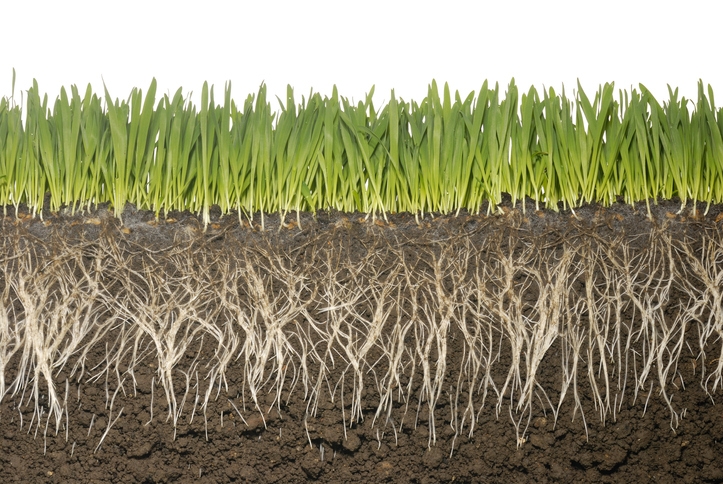
Image - Text Version
Shown is a colour photograph of a cross-section of grass with roots growing down into soil.
A strip of green grass stretches across the photograph near the top. Below that, over half of the photograph shows its roots and the soil underneath. The roots are thin and white, tangled together like hair. All the roots are growing downward, deeper into the soil.
An exception to this rule are the roots of some mangroves. Mangroves are trees or shrubs that grow in regions along saltwater or coastlines. Some of their roots demonstrate negative gravitropism. They grow upwards, out of the soil. This allows them to access oxygen for the plants’ .
Most exhibit negative gravitropism. They grow upwards, against the force of gravity.
If you place a plant on its side, or even upside down, the stem will curve up and the roots will curve down.
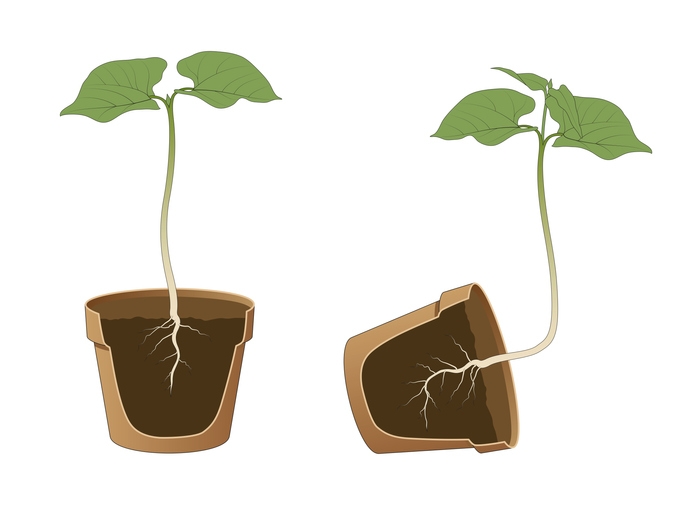
Image - Text Version
Shown is a colour illustration of two potted plants, one upright and one on its side.
Both plants are in small brown pots, cut away to reveal the roots inside. The plant on the left is upright. Its stem grows upwards and its roots grow downwards. The plant pot on the right lies on its side. Its stem has curved to point upwards, perpendicular from its base. Its roots have curved downwards, towards the side of the pot on the ground.
During germination, negative gravitropism helps the seedling's stem find its way up out of the soil and towards the Sun. Positive gravitropism helps the roots grow down deeper into the soil.
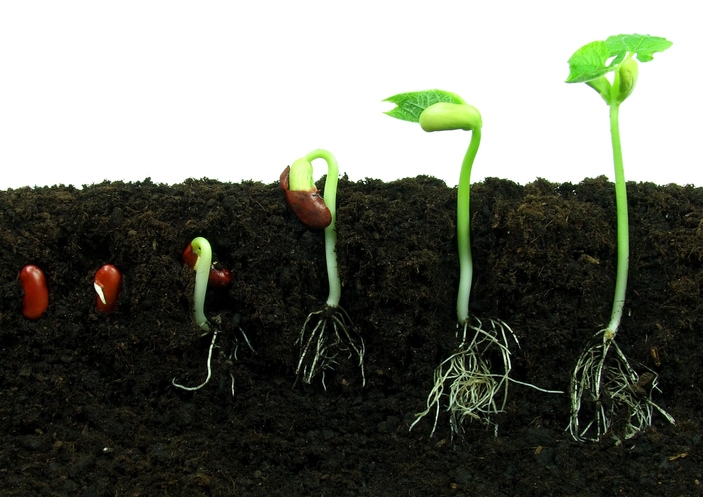
Image - Text Version
Shown is a colour photograph of a cross section of bean seeds at different stages of germination, growing in soil.
Just over half the photograph shows underneath the soil's surface. A row of 6 bean seeds are shown, each at a different stage of germination. On the left is a seed with no growth, on the right is a pale green seedling with several leaves. In each one, the stem grows upwards from the seed, towards and through the surface. The roots grow downwards, deeper into the soil.
Hydrotropism
Hydrotropism is when plants grow towards, or away from water. This tends to happen in the roots, where plants absorb most of their water. If a plant senses water close by, the roots will grow in that direction.
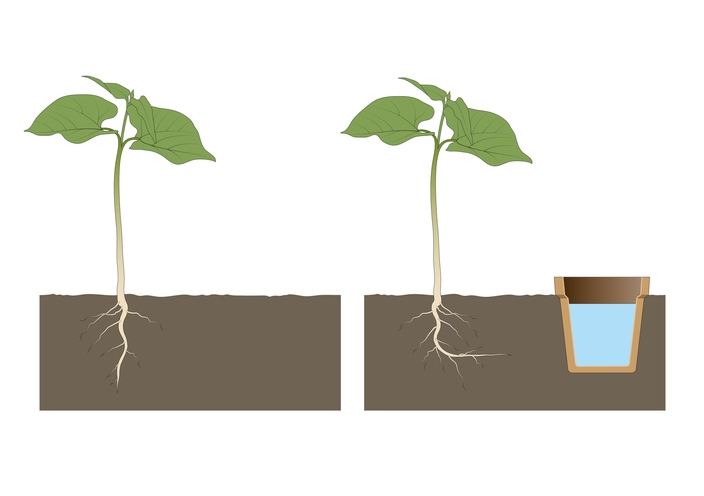
Image - Text Version
Shown is a colour illustration of two plants with a cross-section showing the roots underneath the soil.
In the plant on the left, the stem grows upwards and the roots grow downwards. A pot of water is buried in the soil next to the plant on the right. The roots of this plant have curved around to grow towards the water.
Phototropism
Phototropism is when plants move in response to light. You can do an experiment to see this at home. Give any house plant a single source of light, such as a window. Soon the plant will begin bending towards the light. It grows in that direction to get more light for photosynthesis.
Heliotropism is a type of phototropism. This is when plants move towards the Sun. Sunflowers are well-known heliotropic plants. Young sunflowers bend to follow the Sun during the day, as it moves from east to west. This maximizes the amount of light that reaches the leaves. At night, they bend back to their starting positions, facing east.
Once the plants are mature, they only face east, which helps them to produce pollen and attract pollinators.
Thigmotropism
Thigmotropism is when plants grow in response to touch or contact with objects. For example, vines have small tendrils that curl around walls or trellises. Plants like this don’t usually have strong stems. So, thigmotropism helps them stay upright and keep growing.
Plants in the legume, or bean family, often display thigmotropism.
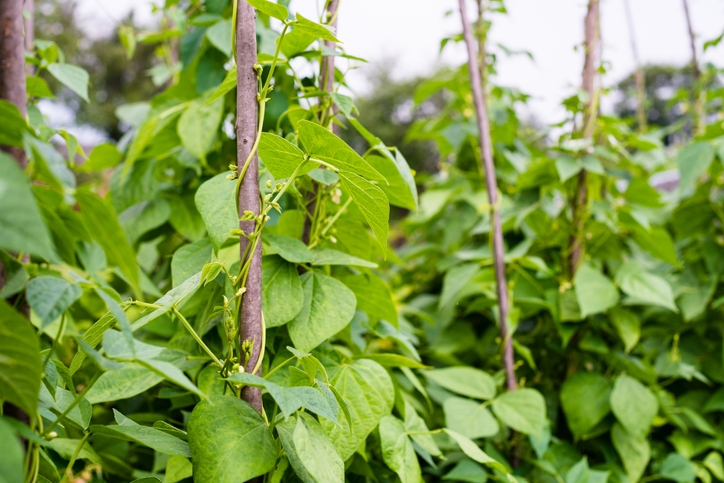
Image - Text Version
Shown is a colour photograph of bean plants with tendrils wrapping around wooden poles.
Most of the frame is filled with bean plants supported by dark brown wooden poles. The plants are thick with wide green leaves. The plant in the foreground is in sharp focus. Its tendrils are thin, pale green and thread-like with smaller growths that curl like corkscrews. The tendrils wind tightly around the pole from the main plant up to the top of the picture.
When plants react instantly to touch, we call it Thigmonasty. This is different from thigmotropism. For example, Mimosa pudica, or “touch-me-not” plants have a thigmonastic reaction. They fold up their leaves when touched. Scientists think this response helps protect the plants from being eaten by insects.
The venus flytrap plan is also thigmonastic. When an insect touches the trigger hairs inside its leaf, the leaf closes shut. Why? Insects are food for the plant. Over time, the plant dissolves the insect inside its leaf and absorbs the nutrients it needs.
History of the Discovery of Phototropism
There is a good chance you have heard of Charles Darwin. He is the scientist and naturalist best known for his book on evolution, The Origin of Species. In addition to his work on evolution, he also did experiments on plant tropisms with his son Francis. They reported their findings in 1880 in a book called, The Power of Movement in Plants. This book had an important impact in plant science.
Charles and Francis studied phototropism using grass and oat seedlings. To test their that the upper part of the was responsible for the seedling bending towards the light, they did a number of controlled experiments. In them, they removed or covered different parts of the seedling with either transparent or opaque materials.
What they discovered supported their hypothesis. It appeared that light was detected by the ends of the coleoptiles.
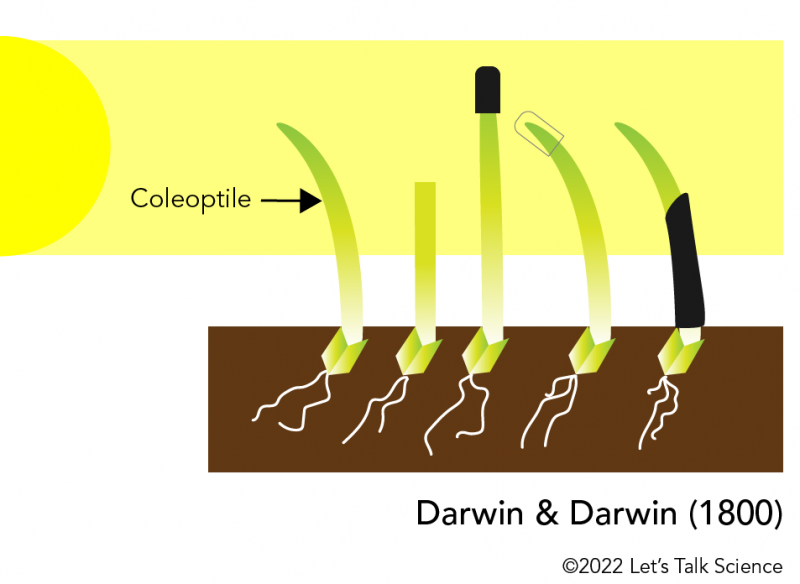
Image - Text Version
Shown is a colour illustration of 5 grass seedlings, altered as they would have been in Charles and Francis Darwin's experiments.
Across the top of the illustration, the sun is represented by a thick, pale yellow stripe, with a bright yellow half-circle on the left side. Near the bottom, a long brown rectangle represents the soil. The roots of each seedling grow downwards in the rectangle. Above the soil, each seedling is about the same size, with a long, pointed structure that becomes darker green near the tip. These are labelled Coleoptile with a black arrow.
The first coleoptile curves left, towards the sun. No alterations are visible on this seedling.
The tip of the second coleoptile has been cut off. This seedling grows straight up, with no curve.
The tip of the third coleoptile is covered with black material. This seedling also grows straight up, with no curve.
The tip of the fourth coleoptile is covered with transparent material. It curves to the left, towards the sun.
The base of the fifth coleoptile, below the tip, is covered in black material. This seedling also curves left, towards the sun.
In 1913, Peter Boysen-Jensen, a Danish plant physiologist, took these experiments a step farther. He was looking for the physiological cause of the bending.
His experiments involved removing the tip of a coleoptile, putting a gelatine block in between the tip and the rest of the plant, and then putting the tip back on. But why gelatine? Although gelatine is a solid, water-soluble chemicals can pass through it.
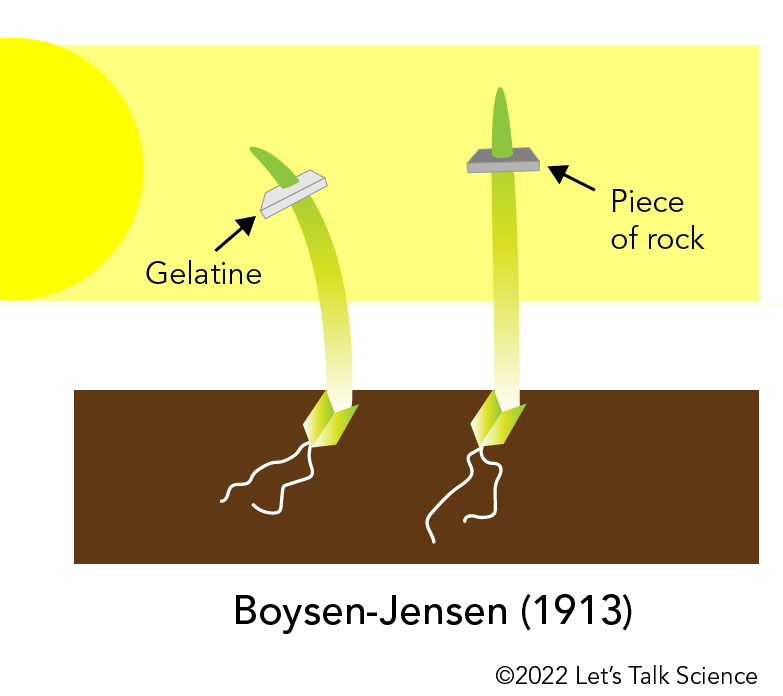
Image - Text Version
Shown is a colour illustration of two grass seedlings, altered as they would have been in Peter Boysen-Jensen's experiments.
Across the top of the illustration, the sun is represented by a thick, pale yellow stripe with a bright yellow half-circle on the left end. Near the bottom, the soil is represented by a dark brown rectangle. The roots of both seedlings grow downwards in the rectangle. Above the soil, both coleoptiles are about the same size.
On the left coleoptile, the tip is separated from the rest of the seedling by a square of grey material. This is labelled Gelatine, with a black arrow. This tip curves to the left, towards the sun.
On the right coleoptile, the tip is separated from the rest of the plant by a square of black material. This is labelled Piece of rock, with a black arrow. This tip points straight up, with no curve.
As mentioned before, gravity is one of the major forces directing the growth of plants. So, what happens to plants in space, where there is ? Scientists discovered that gravity may not be as important as previously thought. They found that even when the force of gravity is very small, roots still grow downward, exhibiting positive gravitropism.
Gravity is not the only factor that directs root growth. Roots grow away from light, and towards water and nutrients. The discovery that plants in space show similar growth to plants growing on Earth is very exciting. This knowledge can be used to plan for growing food on long duration space flights, and on planets like Mars.
Learn More
How do plants find ‘up’?
This activity from Fizzics Education explains the simple experiment to study gravity in plants.
Seven Ways the International Space Station Helps Us Study Plant Growth in Space
This article from NASA explains how scientists are learning about plant growth aboard the ISS.
How Does Gravity Affect Root Growth?
This lesson from BioEd Online allows students to experimentally test effects of gravity on root growth.
Space Station Live: Cultivating Plant Growth in Space (2015)
This video (5:08 min.) from NASA shows the evolution of plant experiments aboard the ISS.
Plants in Space
This classroom activity [pdf] from NASA addresses plant growth tropisms and the effects of the microgravity environment of Earth orbit on plant growth.
References
Ashish. (2022, January 15). Why Do Touch-Me-Not (Mimosa Pudica) Leaves Close When Touched?. Science ABC.
BBC Bitesize. (n. d.) Plant Hormones.
Biology-pages.info. (2021, May 10). Tropisms.
BioMed Central Limited. (2012, December 7). What happens to plant growth when you remove gravity?. ScienceDaily.
Estelle, M. Plant tropisms: The ins and outs of auxin. Current Biology, Volume 6, Issue 12, 1996, 1589-1591. https://doi.org/10.1016/S0960-9822(02)70780-X.
Evolution News & Science Today. (2015, May 26) Darwin, Design, and Phototropism.
Holland, J. J., Roberts, D., Liscum E. Understanding phototropism: from Darwin to today. Journal of Experimental Botany, 60(7),1969–1978, https://doi.org/10.1093/jxb/erp113.
Meeker-O’Connell, A. (n. d.) How Venus Flytraps Work. How Stuff Works.
NASA Johnson. (2012). ISS Update: Plants in Space. YouTube.
Paul, AL., Amalfitano, C.E. & Ferl, R.J. Plant growth strategies are remodeled by spaceflight. BMC Plant Biol 12, 232 (2012). https://doi.org/10.1186/1471-2229-12-232.
plant-and-flower-guide.com. (n. d.) Geotropism.